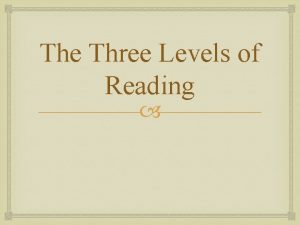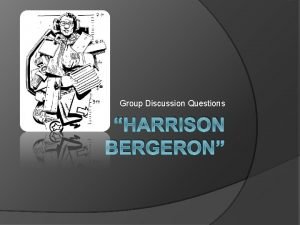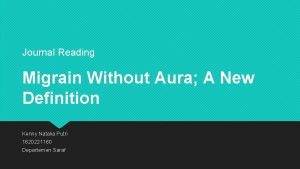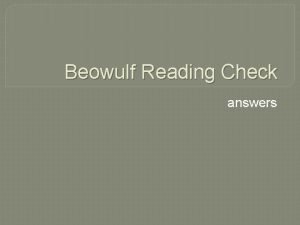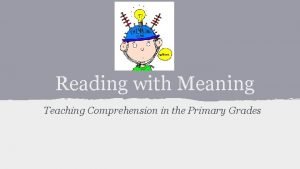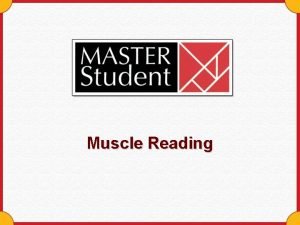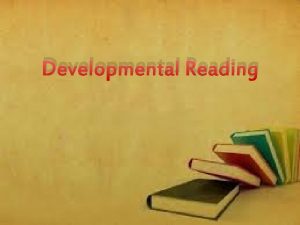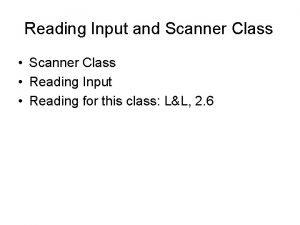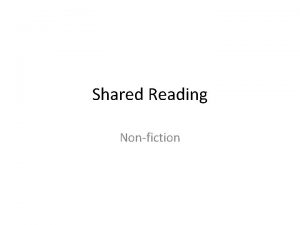Reading 1 Reading n n n Reading is













- Slides: 13

Reading

1. Reading n n n Reading is one of the four basic skills needed to gain competence in mastering a language. It is a written receptive skill. To achieve full comprehension and interaction between the information given and the reader’s expectations is necessary.

2. Reasons for reading and text selection n The ability to read effectively is fundamental for survival in our western society. Whenever we read, we have a specific purpose in mind. Sometimes, we read simply to get the gist of the text or to locate a concrete piece of information.

2. 2. Reasons for reading and text selection Reasons for reading Text selection To get information or search for information Travel brochures Train timetables Bus schedule Public signs Weather forecasts Menus Internet: web sites To satisfy to curiosity about a topic Magazine articles Newspaper editorials Advertisements Internet To follow instructions To know how to use a game Recipes Maps

2. 2. Reasons for reading and text selection Reasons for reading Text selection To keep in touch To find out when and where Announcements Programmes Postcards Letters Notes Messages Invitations Emails

2. 2. Reasons for reading and text selection n Texts should be adapted to the learner’s cognitive development. Texts should cover a wide variety of topics in order to reflect the diversity of interests present in the classroom. Texts should enhance motivation and promote self-esteem.

2. 2. Reasons for reading and text selection n n Texts should reflect situations where the learner can activate his/her schemata and enrich the interpretation. Texts should introduce some of the most important cultural references of the target language. The selected texts should be the result of a needs analysis. By means of a needs analysis the teacher can gather a great deal of valuable information which will result in a more accurate selection of the reading material.

2. 3. Types of knowledge required to make sense of the text Examples Six types of knowledge likely to help the – Position of articles reader to make–sense ofauxiliary the verbs text: Position of n. Types of knowledge Syntactic knowledge – – Position of adjectives and adverbs … Morphological knowledge – – – Word formation (affixation, compounding…) Cohesive devices … General world knowledge Sociocultural knowledge Topic knowledge Genre knowledge Background knowledge – Cultural references – Previous ideas related to the content – – Science fantasy novel Tale Poems …

3. CHARACTERISTICS OF WRITTEN LANGUAGE Permanence The reader can access the information in the written form as many Complexity times Written language tends to have on longer clauses and more complex as needed. Oral language, the contrary, vanishes after being n sentences than spoken language. uttered. Differences in comparison to spoken language. Processing The. Written processing timeusually needed to decode thevaried information is greater Vocabulary: language presents a more and a more formal and time readers read at. The their ownmakes rate. use of more precise lexical items lexicalcan register. writer Distance Theappear. context in which the text is written is different from that in which it is read. Consequently, readers interpret the written material using Written language makes use of conventionalised forms which enable their background knowledge and trying to minimise the effects of the reader to recognise the type of text. In addition to this, a written text passing of some time rhetorical and sociocultural conventions. the reader presents devices which the reader. Besides, should know in cannot confront thetoauthor question text. advance in order make and sense of it. Inhim/her Brown’sabout wordsthe (2001: 306): Formality: Orthography since he/she has more processing time and lower-frequency words often “…conventions topics; … a logical order for, say, are Written languagelike is paragraph materialised through graphemes. These comparing and contrasting something; …. openings and closings; and a accompanied by punctuation marks, pictures or charts. Thus, it may be preference for non-redundancy and subordination clauses, etc. ” more difficult to interpret written language than oral language since this is enriched with suprasegmental features (stress, rhythm, juncture, intonation, pauses, volume, voice quality settings) and non-verbal language (gestures).

4. APPROACHES TO READING IN A FOREIGN/SECOND LANGUAGE n n n 4. 1. Bottom-up process: Based upon the assumption that the reader starts from decoding the most specific levels of the language before grasping the most general ones. The reader first recognises individual letters, forms words, these in turn make up phrases, then clauses, sentences, texts… Later on, he/she makes use of his/her linguistic mechanisms to make some sort of sense of the data.

4. APPROACHES TO READING IN A FOREIGN/SECOND LANGUAGE n Numerous activities to develop the learner’s bottomup strategies and subsequently allow him/her to process the text in this way. n a) Identifying words by letter combinations n b) Difficult sound clusters n c) Re-ordering scrambled words and matching n d) Discriminating minimal pair sounds n e) Reading and stress

4. APPROACHES TO READING IN A FOREIGN/SECOND LANGUAGE n n n 4. 2. Top-down process The process starts from the higher levels of processing and proceeds to use the lower levels selectively. Background knowledge plays a key role since the reader combines what he/she already knows with the new information from the text to achieve a personal interpretation.

Interesting, right? This is just a sneak preview of the full presentation. We hope you like it! To see the rest of it, just click here to view it in full on Power. Show. com. Then, if you’d like, you can also log in to Power. Show. com to download the entire presentation for free.
 Pre reading while reading and post reading activities
Pre reading while reading and post reading activities Edb net
Edb net Characteristics of intensive reading
Characteristics of intensive reading Round robin reading vs popcorn reading
Round robin reading vs popcorn reading Active critical reading
Active critical reading Aims and objectives of teaching
Aims and objectives of teaching Intensive reading and extensive reading
Intensive reading and extensive reading What is reading and types of reading
What is reading and types of reading Extensive reading
Extensive reading What are the three levels of reading
What are the three levels of reading Harrison bergeron questions
Harrison bergeron questions Metode muscle reading
Metode muscle reading Beowulf reading check
Beowulf reading check Reading with meaning
Reading with meaning









